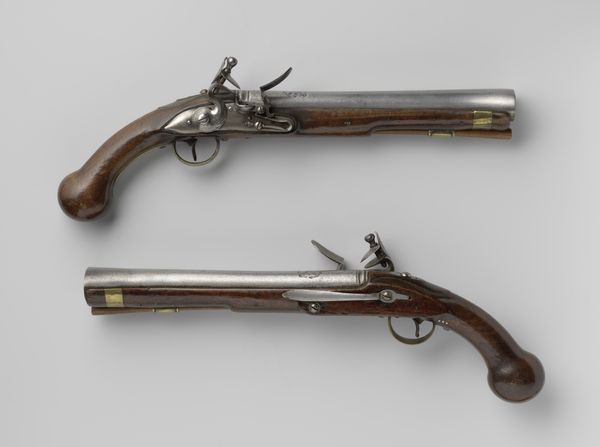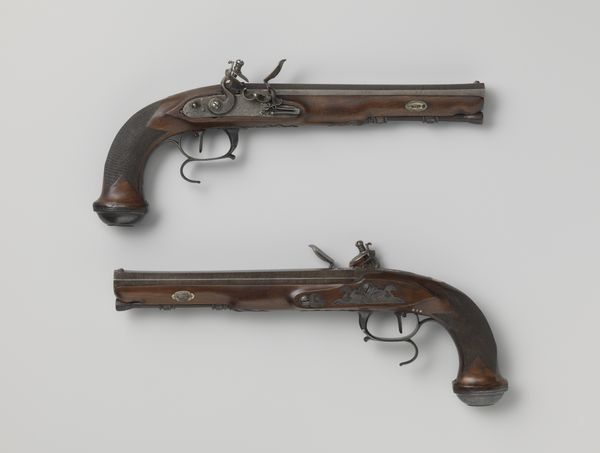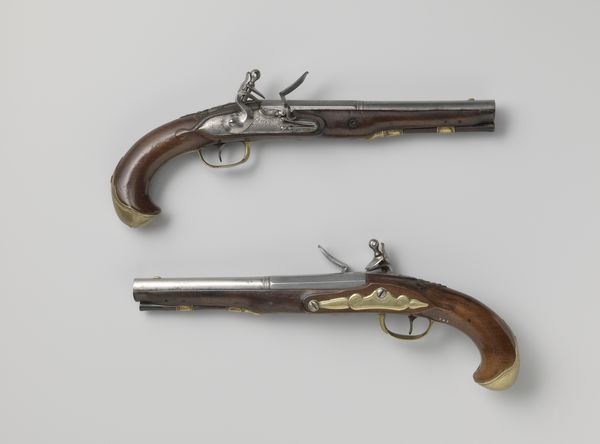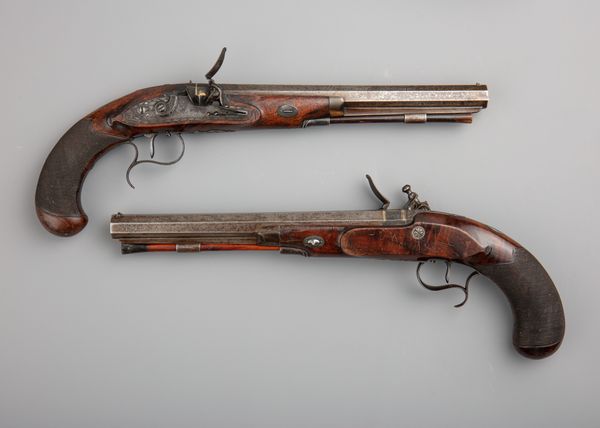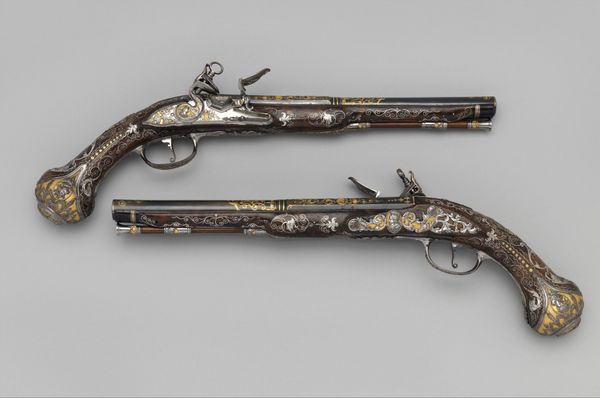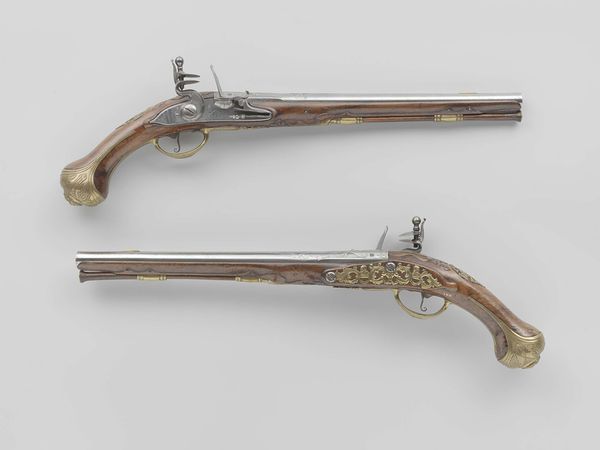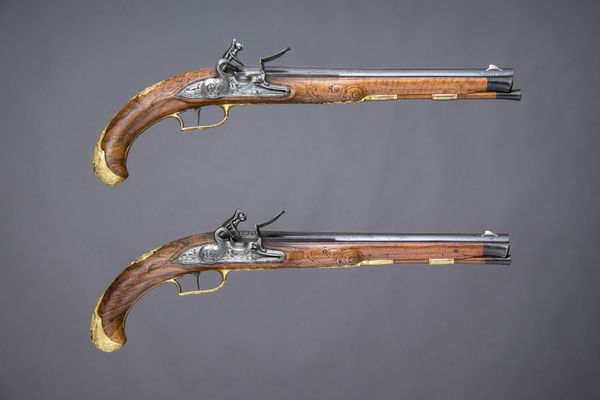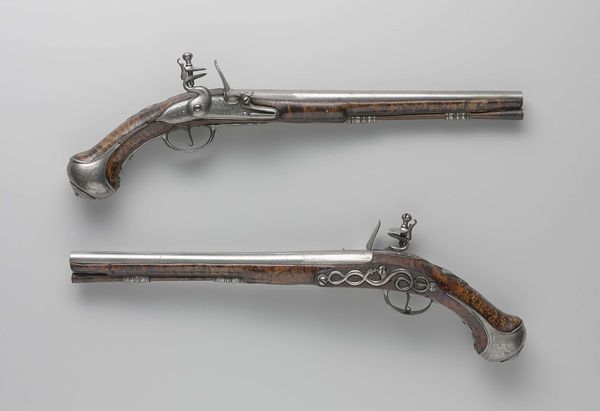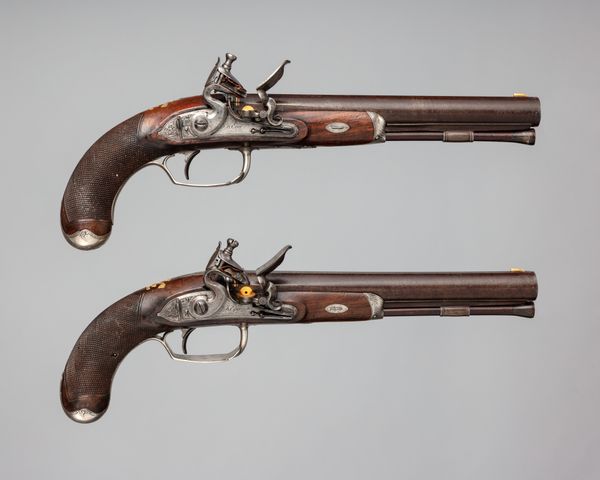
Pair of Flintlock Pistols of the Prince of Wales, later George IV (1762–1830), with Case and Accessories 1787 - 1788
Dimensions: Pistol (a): L. 14 13/16 in. (37.6 cm); L. of barrel 9 13/16 in. (24.9 cm); Cal. .49 in. (12.44 mm); Wt. 1 lb. 11.6 oz. (781 g); pistol (b): L. 14 3/4 in. (37.5 cm); L. of barrel 9 3/4 in. (24.8 cm); Cal. .49 in. (12.44 mm); Wt. 1 lb. 11.7 oz. (783 g); case (c): 18 1/2 x 8 1/2 x 2 13/16 in. (46.99 x 21.59 x 7.14 cm); Wt. 4 lb. 13.4 oz. (2194 g); priming flask (d): 4 7/8 x 2 x 1 5/16 in. (12.38 x 5.08 x 3.33 cm); Wt. 4.20 oz. (119 g); cleaning rod (e): L. 9 1/2 in. (24.13 cm); greatest Diam. (7/16 in. (1.11 cm); Wt. 3.55 oz. (100 g); bullet mold (f): 5 1/2 x 1 5/8 x 11/16 in. (13.97 x 4.13 x 1.75 cm); Wt. 2.75 oz. (78 g); patch cutter (g): 2 7/8 x 1 1/2 x 1 1/4 in. (7.30 x 3.81 x 3.18 cm); Wt. 2.65 oz. (75 g)
Copyright: Public Domain
Curator: Before us is a magnificent pair of flintlock pistols made between 1787 and 1788 by Durs Egg. They once belonged to the Prince of Wales, later King George IV. Editor: They exude power and dominance, and I feel they reflect the political unrest of the period; the refined wood grain contrasts the potential danger and brutality these objects represent. Curator: The construction is exquisite: walrus ivory, gold, steel, and meticulously carved wood, assembled with incredible precision. Notice the delicate engravings and the smooth finish of the wooden stocks; true mastery. Editor: Precisely. I think the pistols tell a story beyond just aesthetics; in what historical contexts were they carried, who might have been targeted? The materials speak volumes about class, power, and the means to violently enforce dominance. Curator: Indeed. And consider the craftsmanship of Durs Egg, a prominent London gunsmith. These pistols exemplify the era’s fascination with decorative arms and their high artistry; Egg made other beautiful firearms that were accessible only to aristocrats and royalty. Editor: It's important to reflect that ownership wasn't accidental but an affirmation of societal hierarchy—who held power and access. We should address who profited from manufacturing, trade and use. Whose hands skillfully created these? Whose lives were at stake by the use of it? Curator: Certainly. But remember these also represented the pinnacle of technology at the time. Gunsmiths like Egg were innovators pushing the boundaries of engineering. Editor: Perhaps. However, to simply celebrate their technological advancement without acknowledging how these tools perpetuated the dispossession of others obscures the wider social cost. The luxury serves to amplify the violent structures inherent during their time, as they served in the hand of an imperial project. Curator: Food for thought. By inspecting their design and the materials, we gain new understanding about the production, distribution, and possession, giving insight into the labor, ownership, and consumption. Editor: Agreed. These artifacts encapsulate artistry and deadly purpose. Engaging in this kind of multilayered conversation is what enriches our knowledge of art history in the broadest context.
Comments
No comments
Be the first to comment and join the conversation on the ultimate creative platform.

